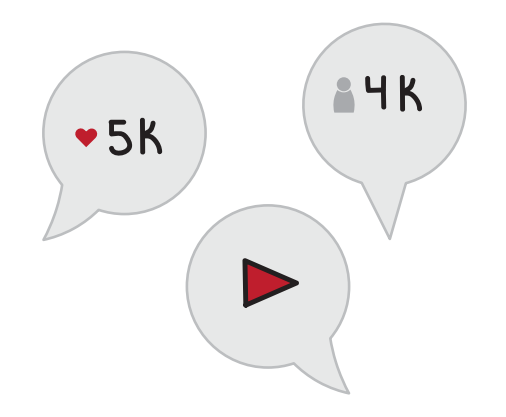What a Way to Make a Living
Influencers Face Questions About the Legitimacy of Their Jobs

Graphic by Amelia Coleman
December 19, 2022
Influencers, or social media creators who have established an influential presence, are taking over social media and the world. According to Forbes, over 50 million people consider themselves influencers; this usually means they have been able to monetize their social media presences on various platforms. The monetization of social media can make it a seriously lucrative business, with the highest paid influencers making up to nine figures a year. Forbes noted that Tik Toker Charli D’Amelio made $17.5 million dollars in 2021 alone. With mega-rich influencers who seem to be popping out of nowhere, public audiences have begun questioning the credibility of influencing as a profession. Although social media content creation does not look like a typical 9-5 job, questioning the legitimacy of influencing discredits the hard work influencers put into their careers.
Influencers’ careers are hard to balance — they need to seem relatable and human to their audiences, but their content needs to always be alluring. This entails sharing details of their personal lives on the internet, but most of this relatable content is painstakingly curated and does not reflect these people’s lives. Fashion micro-influencer, an influencer with less than 1 million followers, Jordan Bunker told The Guardian his life is nothing like it seems on his Instagram. He’s seen modeling for luxurious fashion brands and is always smartly dressed, but many people do not see that he lives with his parents and works on his social media and modeling career at his desk. By only following him on his social media accounts, his fans are not seeing what his life actually looks like.
Because of their curated and filtered faux-relatable content, influencers seem to have it all. However, the upkeep for the job is more than many could handle. Part of influencing is making a life, and by extension a personal brand, desirable. A video blog (vlog) of an influencer attending events, going out, and enjoying their life is, in general, more desirable than showing the hours of editing and planning it took to make that specific vlog. Audiences live off the glitz and glamor of being a social media creator, so influencers do not tend to show the more difficult parts of the job.
Social media is often positioned as a subsection of two industries: marketing and entertainment. Marketing and sponsored posts are the main ways influencers make money. Although many creators can make a profit from monetized posts, brand sponsorships are the most lucrative option. Creators will reach out to brands and market their products through their posts, while the brands pay the creator for their advertising. Behind the scenes work, like advertising and marketing, are an important part of being an influencer, and the job is not just pure posting.
Many large-scale influencers have managers or a whole management team to help them choose sponsored posts and brand partnerships, which leads many to believe that social media figures sit back and relax while others do their job. According to Forbes, managers plan campaigns and posts, upload content for the creator, and analyze data to interpret post interactions. While it may seem like managers do all the work and the creator themselves does nothing, this is not true. Large-scale social media creators are the face of their own personal brand. They have to interact with fans through public appearances and retain a more relatable public persona than the average celebrity. Influencers often have to do their own managing because signing on to a talent agency is an expensive and complicated process not many people can afford. According to Indeed, most micro-influencers do their own management and behind the scenes work, along with filming, photographing, or writing up content for their socials.
Part of social media management is marketing and business collaborations. This marketing is usually harmless, unless the product is illegitimate or could be harmful to the mental health of those it’s targeted at. Social media marketing is wildly successful, which makes legitimate advertising very important. Companies have started to rely on influencers more and more for advertising, which could be dangerous in itself because social media figures may not know the best way to frame or describe a product. However, Forbes stated that 56% of their survey respondents have made a purchase that was advertised to them through social media, and 63% of respondents said they trust social media advertisements more than traditional advertising strategies such as billboards, television ads and pay per click ads (pop-ups on social media or websites, ads in search engines, etc.). Influencers and social media are revolutionizing the marketing industry.
The greatest benefit of social media marketing is increased brand awareness and exposure. Inc. Magazine stated that 78% of small businesses attract new customers by way of social media. Also, Wired projected that in 2020 more than 6 million Instagram posts were sponsored content, and companies were spending up to 10 billion dollars on social media marketing alone. So, not only are influencers making huge amounts of money, marketing and advertising experts are investing their money in influencer marketing. Social media marketing does not just help large corporations, but through influencers many small businesses can open up their audiences and gain new customers that weren’t even aware of their company’s existence.
Influencer audiences are huge, with Pew Research Center stating that 72% of American adults are on social media, which puts a ton of stress on influencers to keep producing popular content. The influencer workload may not seem heavy, but many influencers do not have managers to do all the behind-the-scenes work for them and have to constantly be doing analytics of their own content, planning their own brand collaborations and campaigns, and planning regular non-sponsored content. Influencing doesn’t have a typical 9-5 schedule, so a work-life balance is difficult to achieve when influencers are constantly aware of their job through their phones.
Being an influencer is not that different from other professions in the entertainment industry and criticizing the entire profession of social media influencing because it’s eccentric and does not fit in a traditional desk job template is ignorant and diminishes all the hard work creators and their teams put into the content they post.











